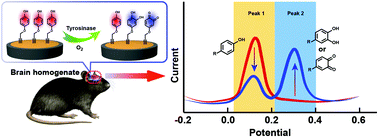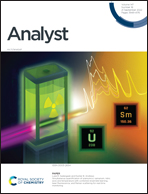A self-ratiometric and selective electrochemical sensor for the detection of tyrosinase in mouse brain homogenate†
Abstract
In this work, we developed a new organic electrochemical probe, 4-(prop-2-yn-1-yloxy)phenol, for the determination of tyrosinase. The designed probe contained a 4-hydroxybenzyloxy moiety for the specific determination of Tyr and a terminal alkyne group for chemical adsorption onto the electrode surface. The oxidation peak of the phenolic group from Pyyp decreased but increased for o-diphenol or o-quinone generated after the reaction between Tyr and Pyyp. The present sensor demonstrated a good linearity with Tyr activity in a dynamic range of 1.0–30 U mL−1. The limit of detection was as low as 0.28 ± 0.12 U mL−1. Moreover, this sensor demonstrated high selectivity for Tyr determination against metal ions, amino acids, ROS and neurotransmitters due to the specific recognition of Tyr. Finally, the developed sensor with high accuracy, high selectivity and long-term stability was successfully applied for evaluating Tyr activity in normal brain homogenate and brain homogenate with Parkinson's disease.



 Please wait while we load your content...
Please wait while we load your content...